John Greaves III's Blog, page 15
January 19, 2017
5 Reasons To Never Insulate Your Garage Door
Deciding to insulate your garage door seems like a great idea at first. Garage athletes experience temperature extremes daily. After all, your garage was designed to keep the rain off of your car and to store miscellaneous junk, not be comfortable enough to spend an hour to two hours a day there in shorts and a t-shirt. But we deal with it. In the summer, we roll up the door, in the winter; we get a portable heater of some kind. But what about those DIY insulate your garage door videos on YouTube ? Are they a good idea? Some of the experts I talked to say maybe not. Here are five reasons you shouldn’t do it.
Adding Insulation Shortens the Lifespan of the Door Hardware
“What wears out on a door are the torsion springs above the door and they just break from wear and tear and from usage. They’re what counterbalance the weight of the door and basically the opener just pulls it back and forth. Average life of an opener is ten to fifteen years with proper care but what will happen with the weight of that insulation is the door will be running heavy, the motor’s going to struggle to pull the door up and you’ll end up stripping the gears inside the opener,” says Roger Kleven who’s worked 15 years in the service department at Contra Costa Door in California’s Bay Area. “I know it doesn’t feel like the insulation weighs very much but it does make a difference, Kleven says.
Possibility of Injury
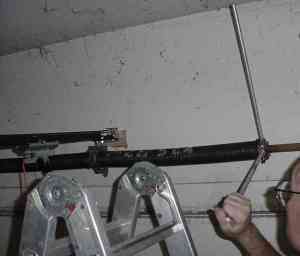 torsion spring backwinding
torsion spring backwindingJust adding door stop weather stripping and a new bottom seal is a project entirely within the capabilities of the average homeowner. To insulate it properly, you’ll have to deal with the torsion springs. “If you insulate a door, they do sell insulation kits, you should have your door re-sprung,” Kleven says. Those springs are under a great deal of tension making it easy to hurt yourself during the replacement process if you’re not a trained professional. Without the springs as a counterweight, the doors themselves are heavy. That’s two potential sources of injury that you need to consider. “For the few hundred dollars it takes for us to install that door, you don’t have to worry about installing it or doing it correctly because there are things that can hurt you. The springs are powerful and you’d have the service tech replace those springs for you,” says Ryan Barth of Pioneer Door of Alaska.
Cost Effectiveness
Brand new garage doors aren’t cheap. “For a plain 16×8 door without any windows, best insulation value, you’re looking right around $3,457.00,” Barth says. In California’s dry heat, prices are also steep. “Replacement insulated doors start at about $1,400 for a complete replacement door with springs, track, hinges and everything included,” Kleven says. But insulating the door yourself isn’t necessarily inexpensive. “If the door’s in good shape and you want to keep the non-insulated door and add insulation to it, you’re probably looking at $350 to put new springs on the door and then balance the door, lube and adjust it,” says Kleven. Barth sees a new door as a better long term deal. “If you have to change the springs, usually a spring change for a double door will be $215. Well, you’re almost ten percent into the cost of a new door at that point,” says Barth. “Really by the time you’re done putting that stuff on there, the insulation value that you’re adding to it is not really doing much at all. You might get one or two R value out of it,” he says.
Premade Doors Insulate Better
The professionals I interviewed agree that premade insulated doors are a better long term option than insulating your current door. Kleven says,“If you want to add insulation to it, the process will definitely be cheaper. It’s not going to be as well insulated the doors that we sell are fully insulated, they’re steel backed on the front and the inside of the door, so they’re a totally insulated door.” Barth, whose employer services an area of Alaska that experiences both 80 degree summers and -20 degree winters, agrees. “We have doors all the way up to three inches thick in a R26. And depending on where you are in the country, a lot of times the R value of your walls, more than likely will be an R21. We’re exceeding that and that way you can get the most bang for your buck” Barth says.
Chance To Improve the Value of the Home
 A new garage door can add value to your home
A new garage door can add value to your homeIf you plan on selling your home in the next three to five years you might not care about the wear and tear on springs but you should care about increasing your home’s resale value. A professionally installed new door can add curb appeal whereas just insulating the garage side of your current door does not. “Say you were walking up to a house that you liked, what would be the first three things that would catch your eye? Walkway, front door and the garage door. Those are three things that you tend to walk on and use normally every day,” Barth says. A higher home value is a big deal if you want a prospective buyer to overlook those cracks from dropping heavy deadlifts on the garage floor. Door Tech of Alaska’s blog quotes Remodel Magazine as saying, “In Alaska you will recoup 98% to 104% for every dollar spent on a new garage door.”
Conclusion
None of these factors mean that you shouldn’t insulate your garage door. It just means you should carefully consider these five factors and any other specific to your situation before choosing the DIY route. You might end up saving money in the long run by just having a professional hang a new door for you that can increase your home’s value and save you hidden costs along the way. “You can do it yourself but it’s always easier to have a professional do it. Also the curb appeal will look nice and will keep that warm or cold outside of your house or your workout area,” Barth says.
Related articles
 Garage Door Opener Logs to Google Drive
Garage Door Opener Logs to Google Drive Lucky cat trapped in garage door miraculously survives horror ordeal
Lucky cat trapped in garage door miraculously survives horror ordeal Wood Stove Prices
Wood Stove Prices The Benefits of a Heater
The Benefits of a Heater Building Energy Efficient Home
Building Energy Efficient Home At Home Living: Garage Doors
At Home Living: Garage Doors Help me turn my rickety old garage into a usable workspace!
Help me turn my rickety old garage into a usable workspace! Having Trouble Heating your Home in the Winter? You Might Have to Buy one of These
Having Trouble Heating your Home in the Winter? You Might Have to Buy one of TheseThe post 5 Reasons To Never Insulate Your Garage Door appeared first on Garage Gym Life.
January 16, 2017
The Garage Gym Project
So Dean, before we dive into The Garage Gym Project tell me: What’s your personal fitness background?
Hi John! In my younger days I was a member of the NZ Olympic Luge team which involved compeitive racing for four years. I held two National titles.
After that I got into a bit of kickboxing . . .
Oh that’s cool! I used to kickbox in the IKF!
. . . nothing serious but I learnt enough to know what it was like to get my face punched in. As I got older I went down that path that many do where inactivity and laziness kicked in. Life was just too busy. It wasn’t until I got engaged I took an interest in getting in shape again. Instead of paying for a gym membership I wanted to see where I could take it by just training at home. After a period of time daily workouts just became routine. That was 10 years ago.
What’s the fitness scene like in New Zealand? You guys have a fair amount of beaches I think so is it sort of like Brazil where people are very aware of their bodies and into staying in shape?
In New Zealand we are very outdoor oriented. There’s lots of watersports, hiking and tramping so a lot of fitness is often woven into people’s hobbies or interests. There’s also sports – rugby, netball etc – and high school sports. For those really into fitness boot camps and cross fit are on the increase. Many people still have the traditional gym memberships too.
How did you start the Garage Gym Kettlebell Club?
A few years ago friends started asking about working out in the garage where I had set up my gym so I thought I’d better take it a step further and get qualified so I gained a certificate in sports training and development at SIT. I also trained in kettlebell instructions with a local RKC instructor. I’ve been training people out of the garage on a casual basis ever since. The Garage Gym Kettlebell Club came from my keen interest in kettlebell training.
 When working with kettlebells, I find chalk grips too much and it restricts movement.
When working with kettlebells, I find chalk grips too much and it restricts movement.I’m planning on taking my first kettlebell certification in 2017. I don’t care about teaching so much as I want to be sure that I’m doing it correctly. I don’t know if I’ll do RKC or StrongFirst but do you have any advice for preparing for it? Or tips for when I’m there beyond just paying attention?
For kettlebell certification, its kind of a catch 22, kettelebell training is very movement technique oriented and without proper instruction most people do the movements wrong. You want to do a certification course to be able to do the movements correctly but yet you need to know the movements in order to train so you can pass the course. My advice is if you can train with a certified RKC of StrongFirst instructor for a bit first. Otherwise, look at a training system like HIIT to build up your endurance. Most kettlebell movements are fast and explosive they tend to tax the respiratory system before your muscles. On a side bar grip strength for kettlebell work is important.
When I did my course with a local RKC instructor a few years ago I found my hands took a beating, because if the bell constantly moving through your grip so take care of your hands, some people like to use chalk. When working with kettlebells, I am the opposite I find chalk grips too much and it restricts movement. If you have good grip strength you shouldn’t need chalk!
So you train mostly your friends. But is your gym available to the public, semi-private or invite only? My brother has had strongman competitors show up to train at his backyard gym because he’s listed on Starting Strongman and I believe CrossFit main site lists places where people can catch a workout if they’re traveling and that includes barbell clubs like yours. Is that something you’d do down the line or do I need to abandon all hope of training with you if I visit New Zealand?
Private for invitees only. Being listed on a fitness directory is something I have never really thought about, but I am all for it. Perhaps its something you could start up, John, to help build the community, if you haven’t already done it. The way I look at it is garage gym training can be a very isolated way of training, that’s probably why we are constantly reading and learning, having someone in the same boat coming along for a workout visit is a great way to learn and see if you are on the right track.
So where’s your gym located? I realize that it’s called The Garage Gym Project but is this an actual garage in someone’s home, a converted car garage, an old mechanic’s garage in the warehouse district?
It’s based out of my garage at home. The car now parks outside!
Since you’re open to the idea of people coming to train, who’s your target clientele?
Trainees are usually friends or colleagues. The Garage Gym Project is more of a hobby than a business. It’s about helping friends with their goals, not making a profit at this stage.
How many people do you normally have in the gym at one time?
There’s usually only one or two people training at a time.
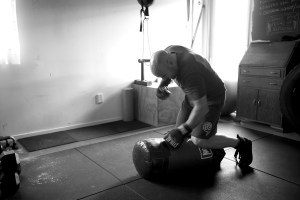 It doesn’t matter what the exercise is as long as you add intensity to it.
It doesn’t matter what the exercise is as long as you add intensity to it.You posted, “It doesn’t have to be complicated. Weighted box step ups are not complicated but the results are in the showing”, is this a good way to sum up how you train people? So tell me about your certifications and/or training philosophy. Are you hardstyle, softstyle? Do you blend kettlebells with other training modalities etc.?
My approach to training is the belief that intensity is key. It doesn’t matter what the exercise is as long as you add intensity to it. It doesn’t need to be complicated to be effective. I break my training into four areas: mobility, strength through heavy lifting, calisthenics with time under tension for tendon and ligament strenght and the rest is about burning calories (which is done through metabolic conditioning, incorporating a variety of tools including kettlebells).
You also said that fitness needs to have purpose. What would you say to someone who says that they’re only interested in training for looks, they don’t want to compete, just look better when they go to the beach or fit into their clothes comfortably again?
The whole purpose of training is to make you feel good about yourself, regardless of whether you want to look good at the beach, fit your clothes or compete in a particular sport. Fitness is a great way to build self-confidence which can then have positive spinoff effects in other parts of your life.
I saw that you do have members who compete, tell me some of your members’ highlights and success stories.
One of my friends I train with in the garage has competed in obstacle races and done well. We have done several together and had great success. My friend has survived cancer at a young age and through that challenge she has become very mentally strong and pushes harder than anyone I know. That drive is reflected in the success of the Garage Gym Project and how we approach training.
So how long have you been up and running as an organized barbell club?
I have been training clients out of my garage for about 3 years now.
Since getting up and running you must have had to face unexpected challenges. I remember we were going out of town and I thought I’d told everybody but I was in Ohio, we live in Georgia so that’s about 10 hours away, anyway one of the kids who trains with my son and I called wanting to know where we were. That was not a good feeling because I hate disappointing kids like that. What have you had to face that was unexpected?
The biggest hurdle I face is scheduling, because I work full time and its shift work. My biggest battle is fitting my time around my clients time, because of this my day generally starts around 5:15am when I get out off bed and get my workout, after that its sorting kids and dropping them off to school & daycare, then its off to work. When I get home I will train clients from about 7-9pm than have dinner and bed.
Tell me about gym set up. A lot of trainers start out going to people’s homes or running boot camps in parks so they have some equipment before they open a brick and mortar gym. When you set up the space did you already have equipment or did you get a space and then get equipment to fill it up?
When I started out I only had basic gear – a couple of kettlebells in the corner of the garage. Over the years I’ve slowly built up better quality equipment and more variety. Moving from a house with a single garage to a large double has given me a bigger space to work in.
I see barbells, kettlebells, dumbbells and assorted combat sports equipment like heavy bags. So who’s been your main supplier of equipment?
I find the best supplier in NZ for equipment is Number 1 Fitness. Unfortunately due to our geographic location there are not a lot of suppliers with affordable equipment.
What’s next for The Garage Gym Project?
My goal is to continue to learn about training and be able to share this with others.
Since you’re into learning give me your top five fitness related books.
Never Gymless: Ross Enamait
Complete Calisthenics. The Ulitmate Guide To Bodyweight Training: Ashley Kalym
Enter the Kettlebell: Pavel Tsatsouline
Becoming a Supple Leopard: Dr. Kelly Starrett
Convict Conditioning: Paul Wade
To follow up on that; I’m a fan of Zach Even Esh, Ross Enamait, James Fuller, Steve Goggins, Stuart McRobert, Mark Bell and the original guys from Barbell Shrugged, among others. Who do you follow as far as other strength coaches and why?
When I first started out my early influences were Ross Enamait. He continues to be an inspiration, as does Dan John.
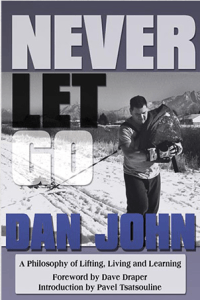 I can’t believe I forgot Dan John! Not only is he a home gym guy but that photo of him from the cover of Never Let Go, dragging a sled in the snow while carrying a sandbag is iconic! I highly recommend everyone subscribe to his newsletter, Dan John’s Wandering Weights”. In fact, I’ll link to that right here.
I can’t believe I forgot Dan John! Not only is he a home gym guy but that photo of him from the cover of Never Let Go, dragging a sled in the snow while carrying a sandbag is iconic! I highly recommend everyone subscribe to his newsletter, Dan John’s Wandering Weights”. In fact, I’ll link to that right here.
But longer term I would like to look at turning this into a business.
That’s cool! Have you started looking at things like insurance, whether or not to hire staff etc? If not, I cannot recommend Barbell Business enough. It’s a podcast run by the early CrossFit box owners of CrossFit Memphis. They also produce the YouTube vlog, Barbell Shrugged which is also very informative. I like listening to their podcast along with Grit2Great whenever I’ve got to drive longer than 20 minutes.
As for insurance and staffing, I am not at that level yet, what I have heard about the US is that getting sued is a common practice, here in NZ it is very difficult to sue people.
Switching gears, I’ve never asked this before but as you have a semi private gym; what’s the goal of your Instagram profile? You’re not necessarily trying to attract members so do you just want to shout out your members’ accomplishments or just motivate others?
There are a lot of people out there that post fitness images on Instagram which I enjoy looking at. I’m a news photographer by trade – working for The New Zealand Herald, NZ’s largest daily newspaper – so photography is a big part of my life. The point of difference for my Instagram page is to put a bit of art into my fitness pictures. That’s why I work in black and white.
trade – working for The New Zealand Herald, NZ’s largest daily newspaper – so photography is a big part of my life. The point of difference for my Instagram page is to put a bit of art into my fitness pictures. That’s why I work in black and white.
I’m really grateful to have had the chance to talk to Dean and get some perspective on the New Zealand at home fitness scene. Everyone can follow Dean’s training on Instagram @the_garage_gym_project. If you’re in New Zealand, feel free to contact him to see if his facility is a good fit for your training goals.
The post The Garage Gym Project appeared first on Garage Gym Life.
January 12, 2017
Increase Your Bench Press
Rear delts get no love from most people who lift weights. That’s a shame because they not only help complete your physique, but also serve to injury proof you if you do a lot of bench pressing. Check out this video from BPI Sports on how to master the rear delt fly and give you 3D shoulder development.
Journey To A Handstand Pushup Part II
Karen Smith, Chief SFB and Master SFG knows that most people would love to be able to do a proper handstand pushup hence this excellent progression series. I posted a link to the first article in this series in Black Friday Bonus: Home Gym Tips and Tricks so if you enjoyed it; here’s part II also on the StrongFirst website.
Five Beginner Level Bridge Exercises
Bridging is awesome for back health and it will improve your bench press by improving your arch. But unless you’re a high school wrestler or gymnast, it’s difficult to find qualified instruction on how to actually do a bridge without hurting yourself! Check out this video from John Sifferman featuring five exercises for beginners to get you started on the road towards more naturally functioning thoracic spine and hopefully more pounds on the flat bench!
Podcast of The Week: The Myths and Truths of Distance Running
Like many people who enjoy weight training, I dislike running. Okay, I hate it. My attitude is mirrored in the reverse by athletes who would rather run 100 miles in any direction rather than do fifteen minutes of strength training. The truth is both camps need to spend time practicing each other’s disciplines. Brett McKay from The Art of Manliness and Jason Fitzgerald of Strength Running dig into myths and truths about distance running including how squatting can improve your race finish time. Follow the link to listen here…
Isometric Movements to Increase Your Bench Press!
A better arch is one way to increase your bench. So is simply getting stronger. Isometrics are a great assistance exercise to nudge your PR higher. Check out Josh Bryant breaking it down in this video with Mark Bell.
The post Increase Your Bench Press appeared first on Garage Gym Life.
Hub Lifting Motivation from Strongman James Fuller
Today’s motivation video is a bit unusual. Yes, it shows James Fuller hub lifting and curling 45lb plates and that is definitely impressive! But it fired me up because James is wearing one of our Garage Gym Life shirts! As I told him in my comments on the video, trying to spread the truth that training outside of a commercial gym isn’t odd; in fact it’s the best option for most of us can feel like an uphill battle on most days. So to see a video like this one, from a strength athlete and world record holder like James Fuller really motivates me to not only train hard but to work harder to get the word out to every athlete who trains at home that they are not alone. We are everywhere and we do it all in house!
Until next week, train hard until people start posting videos of you and don’t forget to support this blog by checking out our Garage Gym Life store complete with cool apparel!
The post Hub Lifting Motivation from Strongman James Fuller appeared first on Garage Gym Life.
January 9, 2017
Hacking Mobility with Julian Sardinas
Everyone’s fitness journey starts somewhere. Talk to me a little about yours. In our first conversation you said that you’ve hung out with athletes for most of your life and some of it’s rubbed off. Expand on that and the role working out has played in your life.
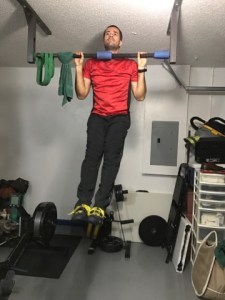 Growing up, I was around and played with great athletes. One had once played professionally, his sons, who were my friends, followed right in their dad’s footsteps. Other friends played in high school, or were just good at sports. So, growing up, I was always playing something outside – football, baseball, basketball, you name it. I was always trying to keep up with them! As we got older, there was less time to play of course so I wanted to make sure that could still keep in shape. I went to the University of Miami and made the best use I could of their amazing gym. Their campus was beautiful for running. After college I continued going to a gym, LA Fitness, to keep in shape and have just continued on with various things over the years. I found Crossfit about 5 years ago and absolutely loved it. I of course have gone through spurts of not going to the gym or not exercising at all (due to injury/getting hurt). A number of years ago I had knee issues (i.e. mainly torn meniscus) that kept me sidelined for a good while. I also got into a gnarly accident (my poor Jeep rolled over and was totaled ) and hurt my neck pretty good from it. From both experiences, I hated not being able move well. I had to get physical therapy and get some really tough deep tissue massages. So, those experiences really influenced me to want to learn how to move well and ultimate to create the UBALL.
Growing up, I was around and played with great athletes. One had once played professionally, his sons, who were my friends, followed right in their dad’s footsteps. Other friends played in high school, or were just good at sports. So, growing up, I was always playing something outside – football, baseball, basketball, you name it. I was always trying to keep up with them! As we got older, there was less time to play of course so I wanted to make sure that could still keep in shape. I went to the University of Miami and made the best use I could of their amazing gym. Their campus was beautiful for running. After college I continued going to a gym, LA Fitness, to keep in shape and have just continued on with various things over the years. I found Crossfit about 5 years ago and absolutely loved it. I of course have gone through spurts of not going to the gym or not exercising at all (due to injury/getting hurt). A number of years ago I had knee issues (i.e. mainly torn meniscus) that kept me sidelined for a good while. I also got into a gnarly accident (my poor Jeep rolled over and was totaled ) and hurt my neck pretty good from it. From both experiences, I hated not being able move well. I had to get physical therapy and get some really tough deep tissue massages. So, those experiences really influenced me to want to learn how to move well and ultimate to create the UBALL.
Something else you told me when we “met” is that you’ve been training in a garage for about six months. You’ve been working out for longer than six months so what was the major factor in you making the move to training at home?
I am not always able to make it to a CrossFit box at their scheduled times. I have a busy schedule at work and, especially during certain parts of the year, I am just not able to leave “on time” and make it to the CF class. And I didn’t really like larger gyms as they tend to be too crowded. Living in apartments, it was hard to have my own gym, but when I bought a house a few years ago having my own garage gym is what I looked forward to the most. Having my gym in my garage really helps me to still be able to obtain a great work out even if I’m not able to go to a physical gym. If I’m running late, I can just work out at any time once I’m home. I just have to be mindful not to drop the weights if it’s too late, the neighbors can hear and feel it! Or, sometimes I wake up late or just get a slow start to the day and can work out in the morning before even going to work. I am still signed up at a great box (LIV UP in Plantation, FL) to have access to a coach as I value that expertise.
Have you read my post about mentors?
I just read it and it’s spot on. I think it’s important to have some guidance especially if your hitting plateaus or getting hurt or just not making progress. These coaches are pros and usually have years of experience and a good “eye”. The tough thing is to find the good ones. My main issue for getting a coach was to help me stay accountable. I also liked how your list has people for spirituality and even repairs (both come in handy).
What other areas do you have mentors in, for example do you have a dedicated soft tissue specialist? Or maybe someone to help you with diet?
I have a sports chiropractor that helps me a lot when I get issues that I can’t seem to fix myself. my Coach at by box (Coach Lo at Liv Up) is also a nutritionist. She has been a big help with fixing and tweaking my diet.
I see gymnastics rings, bumper plates and a utility bench along with barbells in your Instagram pics. What’s your preferred way to train? Are you into bodyweight stuff, powerlifting based, kettlebells or some combination of all those like CrossFit?
Right now, I am working on improving my Oly lifts. However, I still prefer to change it up and incorporate other things (currently trying to get better at squats) and doing CF metcons. Because I have to sit a lot at work and I’m dealing with some nagging injuries I need to do a lot of mobility exercises to be able to move properly. I watch a lot of Kelly Starret’s videos that have been a great help. He is the Mobility Master!
Since you’re a fan of Kelly Starrett’s have you read Deskbound?
I have read parts of the book but I always refer back to his original book the Supple Leopard as well as all of his great videos.
Did you outfit the garage with just the basics to get started or did you go on a shopping spree on the Rogue Fitness website? I have been slowly building my gym for 9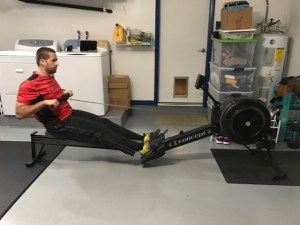 years.
years.
My first purchases where when I lived in an apartment, which were an adjustable dumbbell set (Power Blocks) and a bench. Later, I got a barbell (just the barbell!!), then a pull up bar. When I moved into my home I purchased a Concept rower and then a Squat rack from Rogue as well as rubber mats. I also added second hand bumper and iron plates. The pull up bar came up with me from different homes as they are the ones can be bolted in to the ceiling. (I actually bolted it to the concrete ceiling in one of our apartments we rented, filled in the holes before we moved and brought the bar with us to our garage. I also made my own mobility tool, the UBall, really to address by own needs, but I thought it could help a lot of other athletes, especially ones that work out in their garage. So much of the background you see in my videos at uball.net is in my own garage.
Do you still play sports beyond the recreational level; do you compete in a sport? I still play recreational sports. I enjoy playing basketball with friends and co-workers. I’m always up for a Mudrun or a 5K. I would like to compete in some sort of weightlifting/CF event in near future.
Recreational sports aside, you don’t have anything to get ready for. How do you stay motivated to train day in and day out, by yourself with no one to see?
I enjoy feeling good. When I exercise and do mobility drills, my body feels better. I’m able to free my mind of the daily stuff when I train. This is usually my wind-down session at the end of the day. As I get older, I don’t want to slow down – or, at least no more than I have to. I see these older guys who can run circles around me, lift more than me. I can also do the same for some guys way younger than me. That’s my inspiration.
Since, I started this journey, I have to, now more than ever, take my training more seriously. I don’t care so much over how I look, I care more about how I feel and about getting stronger. Which both help with appearance anyways.
I’m a huge believer in the role environment plays in having good workouts. Everything from where equipment is placed to what I hang on the wall is geared to put me in the right frame of mind to train hard. Do you have any posters in your garage gym or banners that help you get focused?
I don’t have banners on the wall, but plan to in the future. However, I do play music. This is really my time to clear my mind and enjoy some time to myself.
What kind of music do you prefer when you train? Loud and energetic or more calming stuff?
I listen to various things depending on mood but for most part ‘m a bit old school so some 80s, sometimes a little jazz, or Christian music or mix of it all. But I really like to make it funky with some good old James Brown. Like he once said, “You can’t get up if you can’t get down!”
I mentioned Rogue Fitness as a catchall for equipment providers but where have you found the best, most user friendly shopping experience?
Rogue is now the gold standard. They have great quality and good prices, especially for important things like a rack/rig. Other times I found can be bought at second hand store or Craigslist (for example bumper plates).
An interesting purchase I made was for my Rubber flooring. Usually that can be very expensive but I found out that the rubber mats used in horse stalls are very similar material and thickness yet cost about half!
What’s next on your wish list?
A few future purchases are a prowler (I saw one with wheels which I’m sure my neighbors would appreciate), GHD machine, Atlas stones, and a climbing rope.
What’s So Great About The UBall?
Garage gym life tends to inspire creative engineering. Whether it’s because we don’t have access to all of the toys or because we have the freedom that comes from owning the facility, we come up with a lot of ideas to make our training more effective. You have a mobility product called the uBall and without turning this into a commercial for it, talk about the role training at home alone played in developing it.
Training at home was huge for this as I used my garage to do various mobility drills. But I always had the question of, “How can I get that same massage-like feeling, on my own, at home?” I have lots of mobility tools, I still wasn’t getting the same feeling or results as I did when I’d go to a PT. The only thing that came close was: 1) taping a ball to a barbell – which was a mess and time consuming or 2) my wife’s elbow, that often got tired. So, I got the idea to make my own little device. I saw how wonderful it worked, l loved it, and realized I was on to something and that others could use it.
A lot of us come up with great ideas but not all of us take the time to make that product available in the marketplace. What was it about this product that made you say, this is worth the headache of trademarking, product development etc?
Great question. Well, I used it on myself for a while, and just kept thinking how it could help a lot of people, especially with the same desire to move better/reduce injury. It wasn’t a decision I took lightly because like you said, I knew it was going to be a long road ahead and spend a significant amount of time and resources, but it really felt like something worth pursuing. And I’m still on the road, but I believe in this product and that it can help others. I believe that when used appropriately, it can really help a person move and feel better. So, knowing how good it is, it pushes me forward knowing that something good can come from it.
I don’t have many friends who work out. Most of them don’t even comment about it beyond occasional comments when I post something on Facebook or if they come over and see a new piece of equipment. What role do your family and friends play in supporting your fitness lifestyle?
I’d have to say it’s very similar to yours. My wife works out occasionally. She’s not much for weights, more for light cardio. She does try to help me with my diet and to not bring in what we like to call “contraband” (aka sweets). But none of my family works out, I don’t really say much to them about it. However, I have some awesome coworker friends that are a great group of guys, that are into fitness and have they’ve been very helpful. Also, I still like the environment of a CF gym so as I said before, I go about once a week/every other week to an amazing box, LIV UP CrossFit, that the coaches and athletes are super nice people and know their stuff.
You’re six months into this as we have this conversation, what have you learned about the process of setting up a home gym that you wish you’d known going into it?
I wish I could have done it sooner!! When I bought my house I got my squat rack right away and I have been more consistent than before. The only thing I wish I could have done better is plan the layout better. I had to move it around a couple times before I got it right. Also weather was important consideration. I’m in Florida so In the summer a good large fan was is a must! The other thing for me is to be patient and get good quality things even if they are a bit costly. Somethings are okay cheap (like the plates) but others are better to get quality stuff (like a rack/rig or barbell).
Parting Advice
What advice would you give to someone reading this who may have just decided to start training at home?
Start out with foundational pieces – like a barbell, enough weights to grow into, rack/rig, dumbbells if possible (adjustable ones are best), bands, maybe a jump rope, and some mobility tools and then grow from there. Create goals and work towards it. Find a good coach (in person online) or program to follow. Unless you really know what you are doing programming can be hard. Create a consistent time you want to work out and stick to it Make sure you track your training to see progress and how many times you train a week.
How can people contact you if they want more information about the UBALL or just want to keep up with your training?
People are welcome to email me at julian@uball.net and sign up for our newsletter at UBALL.net or they can follow me on Instagram and Facebook @uballnet.
Anything else you need from me to help you out? Would you like a promo code for your readers?
Promo codes are ALWAYS welcome man!
Julian was as good as his word so members of the Garage Gym Life community can save 10% off the purchase of a UBALL and get a free bungee cord from www.uball.net with promo code: GARAGE GYM LIFE at checkout!
The post Hacking Mobility with Julian Sardinas appeared first on Garage Gym Life.
UBALL creator Julian Sardinas
Everyone’s fitness journey starts somewhere. Talk to me a little about yours. In our first conversation you said that you’ve hung out with athletes for most of your life and some of it’s rubbed off. Expand on that and the role working out has played in your life.
 Growing up, I was around and played with great athletes. One had once played professionally, his sons, who were my friends, followed right in their dad’s footsteps. Other friends played in high school, or were just good at sports. So, growing up, I was always playing something outside – football, baseball, basketball, you name it. I was always trying to keep up with them! As we got older, there was less time to play of course so I wanted to make sure that could still keep in shape. I went to the University of Miami and made the best use I could of their amazing gym. Their campus was beautiful for running. After college I continued going to a gym, LA Fitness, to keep in shape and have just continued on with various things over the years. I found Crossfit about 5 years ago and absolutely loved it. I of course have gone through spurts of not going to the gym or not exercising at all (due to injury/getting hurt). A number of years ago I had knee issues (i.e. mainly torn meniscus) that kept me sidelined for a good while. I also got into a gnarly accident (my poor Jeep rolled over and was totaled ) and hurt my neck pretty good from it. From both experiences, I hated not being able move well. I had to get physical therapy and get some really tough deep tissue massages. So, those experiences really influenced me to want to learn how to move well and ultimate to create the UBALL.
Growing up, I was around and played with great athletes. One had once played professionally, his sons, who were my friends, followed right in their dad’s footsteps. Other friends played in high school, or were just good at sports. So, growing up, I was always playing something outside – football, baseball, basketball, you name it. I was always trying to keep up with them! As we got older, there was less time to play of course so I wanted to make sure that could still keep in shape. I went to the University of Miami and made the best use I could of their amazing gym. Their campus was beautiful for running. After college I continued going to a gym, LA Fitness, to keep in shape and have just continued on with various things over the years. I found Crossfit about 5 years ago and absolutely loved it. I of course have gone through spurts of not going to the gym or not exercising at all (due to injury/getting hurt). A number of years ago I had knee issues (i.e. mainly torn meniscus) that kept me sidelined for a good while. I also got into a gnarly accident (my poor Jeep rolled over and was totaled ) and hurt my neck pretty good from it. From both experiences, I hated not being able move well. I had to get physical therapy and get some really tough deep tissue massages. So, those experiences really influenced me to want to learn how to move well and ultimate to create the UBALL.
Something else you told me when we “met” is that you’ve been training in a garage for about six months. You’ve been working out for longer than six months so what was the major factor in you making the move to training at home?
I am not always able to make it to a CrossFit box at their scheduled times. I have a busy schedule at work and, especially during certain parts of the year, I am just not able to leave “on time” and make it to the CF class. And I didn’t really like larger gyms as they tend to be too crowded. Living in apartments, it was hard to have my own gym, but when I bought a house a few years ago having my own garage gym is what I looked forward to the most. Having my gym in my garage really helps me to still be able to obtain a great work out even if I’m not able to go to a physical gym. If I’m running late, I can just work out at any time once I’m home. I just have to be mindful not to drop the weights if it’s too late, the neighbors can hear and feel it! Or, sometimes I wake up late or just get a slow start to the day and can work out in the morning before even going to work. I am still signed up at a great box (LIV UP in Plantation, FL) to have access to a coach as I value that expertise.
Have you read my post about mentors?
I just read it and it’s spot on. I think it’s important to have some guidance especially if your hitting plateaus or getting hurt or just not making progress. These coaches are pros and usually have years of experience and a good “eye”. The tough thing is to find the good ones. My main issue for getting a coach was to help me stay accountable. I also liked how your list has people for spirituality and even repairs (both come in handy).
What other areas do you have mentors in, for example do you have a dedicated soft tissue specialist? Or maybe someone to help you with diet?
I have a sports chiropractor that helps me a lot when I get issues that I can’t seem to fix myself. my Coach at by box (Coach Lo at Liv Up) is also a nutritionist. She has been a big help with fixing and tweaking my diet.
I see gymnastics rings, bumper plates and a utility bench along with barbells in your Instagram pics. What’s your preferred way to train? Are you into bodyweight stuff, powerlifting based, kettlebells or some combination of all those like CrossFit?
Right now, I am working on improving my Oly lifts. However, I still prefer to change it up and incorporate other things (currently trying to get better at squats) and doing CF metcons. Because I have to sit a lot at work and I’m dealing with some nagging injuries I need to do a lot of mobility exercises to be able to move properly. I watch a lot of Kelly Starret’s videos that have been a great help. He is the Mobility Master!
Since you’re a fan of Kelly Starrett’s have you read Deskbound?
I have read parts of the book but I always refer back to his original book the Supple Leopard as well as all of his great videos.
Did you outfit the garage with just the basics to get started or did you go on a shopping spree on the Rogue Fitness website? I have been slowly building my gym for 9 years.
years.
My first purchases where when I lived in an apartment, which were an adjustable dumbbell set (Power Blocks) and a bench. Later, I got a barbell (just the barbell!!), then a pull up bar. When I moved into my home I purchased a Concept rower and then a Squat rack from Rogue as well as rubber mats. I also added second hand bumper and iron plates. The pull up bar came up with me from different homes as they are the ones can be bolted in to the ceiling. (I actually bolted it to the concrete ceiling in one of our apartments we rented, filled in the holes before we moved and brought the bar with us to our garage. I also made my own mobility tool, the UBall, really to address by own needs, but I thought it could help a lot of other athletes, especially ones that work out in their garage. So much of the background you see in my videos at uball.net is in my own garage.
Do you still play sports beyond the recreational level; do you compete in a sport? I still play recreational sports. I enjoy playing basketball with friends and co-workers. I’m always up for a Mudrun or a 5K. I would like to compete in some sort of weightlifting/CF event in near future.
Recreational sports aside, you don’t have anything to get ready for. How do you stay motivated to train day in and day out, by yourself with no one to see?
I enjoy feeling good. When I exercise and do mobility drills, my body feels better. I’m able to free my mind of the daily stuff when I train. This is usually my wind-down session at the end of the day. As I get older, I don’t want to slow down – or, at least no more than I have to. I see these older guys who can run circles around me, lift more than me. I can also do the same for some guys way younger than me. That’s my inspiration.
Since, I started this journey, I have to, now more than ever, take my training more seriously. I don’t care so much over how I look, I care more about how I feel and about getting stronger. Which both help with appearance anyways.
I’m a huge believer in the role environment plays in having good workouts. Everything from where equipment is placed to what I hang on the wall is geared to put me in the right frame of mind to train hard. Do you have any posters in your garage gym or banners that help you get focused?
I don’t have banners on the wall, but plan to in the future. However, I do play music. This is really my time to clear my mind and enjoy some time to myself.
What kind of music do you prefer when you train? Loud and energetic or more calming stuff?
I listen to various things depending on mood but for most part ‘m a bit old school so some 80s, sometimes a little jazz, or Christian music or mix of it all. But I really like to make it funky with some good old James Brown. Like he once said, “You can’t get up if you can’t get down!”
I mentioned Rogue Fitness as a catchall for equipment providers but where have you found the best, most user friendly shopping experience?
Rogue is now the gold standard. They have great quality and good prices, especially for important things like a rack/rig. Other times I found can be bought at second hand store or Craigslist (for example bumper plates).
An interesting purchase I made was for my Rubber flooring. Usually that can be very expensive but I found out that the rubber mats used in horse stalls are very similar material and thickness yet cost about half!
What’s next on your wish list?
A few future purchases are a prowler (I saw one with wheels which I’m sure my neighbors would appreciate), GHD machine, Atlas stones, and a climbing rope.
What’s So Great About The UBall?
Garage gym life tends to inspire creative engineering. Whether it’s because we don’t have access to all of the toys or because we have the freedom that comes from owning the facility, we come up with a lot of ideas to make our training more effective. You have a mobility product called the uBall and without turning this into a commercial for it, talk about the role training at home alone played in developing it.
Training at home was huge for this as I used my garage to do various mobility drills. But I always had the question of, “How can I get that same massage-like feeling, on my own, at home?” I have lots of mobility tools, I still wasn’t getting the same feeling or results as I did when I’d go to a PT. The only thing that came close was: 1) taping a ball to a barbell – which was a mess and time consuming or 2) my wife’s elbow, that often got tired. So, I got the idea to make my own little device. I saw how wonderful it worked, l loved it, and realized I was on to something and that others could use it.
A lot of us come up with great ideas but not all of us take the time to make that product available in the marketplace. What was it about this product that made you say, this is worth the headache of trademarking, product development etc?
Great question. Well, I used it on myself for a while, and just kept thinking how it could help a lot of people, especially with the same desire to move better/reduce injury. It wasn’t a decision I took lightly because like you said, I knew it was going to be a long road ahead and spend a significant amount of time and resources, but it really felt like something worth pursuing. And I’m still on the road, but I believe in this product and that it can help others. I believe that when used appropriately, it can really help a person move and feel better. So, knowing how good it is, it pushes me forward knowing that something good can come from it.
I don’t have many friends who work out. Most of them don’t even comment about it beyond occasional comments when I post something on Facebook or if they come over and see a new piece of equipment. What role do your family and friends play in supporting your fitness lifestyle?
I’d have to say it’s very similar to yours. My wife works out occasionally. She’s not much for weights, more for light cardio. She does try to help me with my diet and to not bring in what we like to call “contraband” (aka sweets). But none of my family works out, I don’t really say much to them about it. However, I have some awesome coworker friends that are a great group of guys, that are into fitness and have they’ve been very helpful. Also, I still like the environment of a CF gym so as I said before, I go about once a week/every other week to an amazing box, LIV UP CrossFit, that the coaches and athletes are super nice people and know their stuff.
You’re six months into this as we have this conversation, what have you learned about the process of setting up a home gym that you wish you’d known going into it?
I wish I could have done it sooner!! When I bought my house I got my squat rack right away and I have been more consistent than before. The only thing I wish I could have done better is plan the layout better. I had to move it around a couple times before I got it right. Also weather was important consideration. I’m in Florida so In the summer a good large fan was is a must! The other thing for me is to be patient and get good quality things even if they are a bit costly. Somethings are okay cheap (like the plates) but others are better to get quality stuff (like a rack/rig or barbell).
Parting Advice
What advice would you give to someone reading this who may have just decided to start training at home?
Start out with foundational pieces – like a barbell, enough weights to grow into, rack/rig, dumbbells if possible (adjustable ones are best), bands, maybe a jump rope, and some mobility tools and then grow from there. Create goals and work towards it. Find a good coach (in person online) or program to follow. Unless you really know what you are doing programming can be hard. Create a consistent time you want to work out and stick to it Make sure you track your training to see progress and how many times you train a week.
How can people contact you if they want more information about the UBALL or just want to keep up with your training?
People are welcome to email me at julian@uball.net and sign up for our newsletter at UBALL.net or they can follow me on Instagram and Facebook @uballnet.
Anything else you need from me to help you out? Would you like a promo code for your readers?
Promo codes are ALWAYS welcome man!
Julian was as good as his word so members of the Garage Gym Life community can save 10% off the purchase of a UBALL and get a free bungee cord from www.uball.net with promo code: GARAGE GYM LIFE at checkout!
The post UBALL creator Julian Sardinas appeared first on Garage Gym Life.
UBall Creator Julian Sardinas Talks At Home Training and Mobility
Everyone’s fitness journey starts somewhere. Talk to me a little about yours. In our first conversation you said that you’ve hung out with athletes for most of your life and some of it’s rubbed off. Expand on that and the role working out has played in your life.
 Growing up, I was around and played with great athletes. One had once played professionally, his sons, who were my friends, followed right in their dad’s footsteps. Other friends played in high school, or were just good at sports. So, growing up, I was always playing something outside – football, baseball, basketball, you name it. I was always trying to keep up with them! As we got older, there was less time to play of course so I wanted to make sure that could still keep in shape. I went to the University of Miami and made the best use I could of their amazing gym. Their campus was beautiful for running. After college I continued going to a gym, LA Fitness, to keep in shape and have just continued on with various things over the years. I found Crossfit about 5 years ago and absolutely loved it. I of course have gone through spurts of not going to the gym or not exercising at all (due to injury/getting hurt). A number of years ago I had knee issues (i.e. mainly torn meniscus) that kept me sidelined for a good while. I also got into a gnarly accident (my poor Jeep rolled over and was totaled ) and hurt my neck pretty good from it. From both experiences, I hated not being able move well. I had to get physical therapy and get some really tough deep tissue massages. So, those experiences really influenced me to want to learn how to move well and ultimate to create the UBALL.
Growing up, I was around and played with great athletes. One had once played professionally, his sons, who were my friends, followed right in their dad’s footsteps. Other friends played in high school, or were just good at sports. So, growing up, I was always playing something outside – football, baseball, basketball, you name it. I was always trying to keep up with them! As we got older, there was less time to play of course so I wanted to make sure that could still keep in shape. I went to the University of Miami and made the best use I could of their amazing gym. Their campus was beautiful for running. After college I continued going to a gym, LA Fitness, to keep in shape and have just continued on with various things over the years. I found Crossfit about 5 years ago and absolutely loved it. I of course have gone through spurts of not going to the gym or not exercising at all (due to injury/getting hurt). A number of years ago I had knee issues (i.e. mainly torn meniscus) that kept me sidelined for a good while. I also got into a gnarly accident (my poor Jeep rolled over and was totaled ) and hurt my neck pretty good from it. From both experiences, I hated not being able move well. I had to get physical therapy and get some really tough deep tissue massages. So, those experiences really influenced me to want to learn how to move well and ultimate to create the UBALL.
Something else you told me when we “met” is that you’ve been training in a garage for about six months. You’ve been working out for longer than six months so what was the major factor in you making the move to training at home?
I am not always able to make it to a CrossFit box at their scheduled times. I have a busy schedule at work and, especially during certain parts of the year, I am just not able to leave “on time” and make it to the CF class. And I didn’t really like larger gyms as they tend to be too crowded. Living in apartments, it was hard to have my own gym, but when I bought a house a few years ago having my own garage gym is what I looked forward to the most. Having my gym in my garage really helps me to still be able to obtain a great work out even if I’m not able to go to a physical gym. If I’m running late, I can just work out at any time once I’m home. I just have to be mindful not to drop the weights if it’s too late, the neighbors can hear and feel it! Or, sometimes I wake up late or just get a slow start to the day and can work out in the morning before even going to work. I am still signed up at a great box (LIV UP in Plantation, FL) to have access to a coach as I value that expertise.
Have you read my post about mentors?
I just read it and it’s spot on. I think it’s important to have some guidance especially if your hitting plateaus or getting hurt or just not making progress. These coaches are pros and usually have years of experience and a good “eye”. The tough thing is to find the good ones. My main issue for getting a coach was to help me stay accountable. I also liked how your list has people for spirituality and even repairs (both come in handy).
What other areas do you have mentors in, for example do you have a dedicated soft tissue specialist? Or maybe someone to help you with diet?
I have a sports chiropractor that helps me a lot when I get issues that I can’t seem to fix myself. my Coach at by box (Coach Lo at Liv Up) is also a nutritionist. She has been a big help with fixing and tweaking my diet.
I see gymnastics rings, bumper plates and a utility bench along with barbells in your Instagram pics. What’s your preferred way to train? Are you into bodyweight stuff, powerlifting based, kettlebells or some combination of all those like CrossFit?
Right now, I am working on improving my Oly lifts. However, I still prefer to change it up and incorporate other things (currently trying to get better at squats) and doing CF metcons. Because I have to sit a lot at work and I’m dealing with some nagging injuries I need to do a lot of mobility exercises to be able to move properly. I watch a lot of Kelly Starret’s videos that have been a great help. He is the Mobility Master!
Since you’re a fan of Kelly Starrett’s have you read Deskbound?
I have read parts of the book but I always refer back to his original book the Supple Leopard as well as all of his great videos.
Did you outfit the garage with just the basics to get started or did you go on a shopping spree on the Rogue Fitness website? I have been slowly building my gym for 9 years.
years.
My first purchases where when I lived in an apartment, which were an adjustable dumbbell set (Power Blocks) and a bench. Later, I got a barbell (just the barbell!!), then a pull up bar. When I moved into my home I purchased a Concept rower and then a Squat rack from Rogue as well as rubber mats. I also added second hand bumper and iron plates. The pull up bar came up with me from different homes as they are the ones can be bolted in to the ceiling. (I actually bolted it to the concrete ceiling in one of our apartments we rented, filled in the holes before we moved and brought the bar with us to our garage. I also made my own mobility tool, the UBall, really to address by own needs, but I thought it could help a lot of other athletes, especially ones that work out in their garage. So much of the background you see in my videos at uball.net is in my own garage.
Do you still play sports beyond the recreational level; do you compete in a sport? I still play recreational sports. I enjoy playing basketball with friends and co-workers. I’m always up for a Mudrun or a 5K. I would like to compete in some sort of weightlifting/CF event in near future.
Recreational sports aside, you don’t have anything to get ready for. How do you stay motivated to train day in and day out, by yourself with no one to see?
I enjoy feeling good. When I exercise and do mobility drills, my body feels better. I’m able to free my mind of the daily stuff when I train. This is usually my wind-down session at the end of the day. As I get older, I don’t want to slow down – or, at least no more than I have to. I see these older guys who can run circles around me, lift more than me. I can also do the same for some guys way younger than me. That’s my inspiration.
Since, I started this journey, I have to, now more than ever, take my training more seriously. I don’t care so much over how I look, I care more about how I feel and about getting stronger. Which both help with appearance anyways.
I’m a huge believer in the role environment plays in having good workouts. Everything from where equipment is placed to what I hang on the wall is geared to put me in the right frame of mind to train hard. Do you have any posters in your garage gym or banners that help you get focused?
I don’t have banners on the wall, but plan to in the future. However, I do play music. This is really my time to clear my mind and enjoy some time to myself.
What kind of music do you prefer when you train? Loud and energetic or more calming stuff?
I listen to various things depending on mood but for most part ‘m a bit old school so some 80s, sometimes a little jazz, or Christian music or mix of it all. But I really like to make it funky with some good old James Brown. Like he once said, “You can’t get up if you can’t get down!”
I mentioned Rogue Fitness as a catchall for equipment providers but where have you found the best, most user friendly shopping experience?
Rogue is now the gold standard. They have great quality and good prices, especially for important things like a rack/rig. Other times I found can be bought at second hand store or Craigslist (for example bumper plates).
An interesting purchase I made was for my Rubber flooring. Usually that can be very expensive but I found out that the rubber mats used in horse stalls are very similar material and thickness yet cost about half!
What’s next on your wish list?
A few future purchases are a prowler (I saw one with wheels which I’m sure my neighbors would appreciate), GHD machine, Atlas stones, and a climbing rope.
What’s So Great About The UBall?
Garage gym life tends to inspire creative engineering. Whether it’s because we don’t have access to all of the toys or because we have the freedom that comes from owning the facility, we come up with a lot of ideas to make our training more effective. You have a mobility product called the uBall and without turning this into a commercial for it, talk about the role training at home alone played in developing it.
Training at home was huge for this as I used my garage to do various mobility drills. But I always had the question of, “How can I get that same massage-like feeling, on my own, at home?” I have lots of mobility tools, I still wasn’t getting the same feeling or results as I did when I’d go to a PT. The only thing that came close was: 1) taping a ball to a barbell – which was a mess and time consuming or 2) my wife’s elbow, that often got tired. So, I got the idea to make my own little device. I saw how wonderful it worked, l loved it, and realized I was on to something and that others could use it.
A lot of us come up with great ideas but not all of us take the time to make that product available in the marketplace. What was it about this product that made you say, this is worth the headache of trademarking, product development etc?
Great question. Well, I used it on myself for a while, and just kept thinking how it could help a lot of people, especially with the same desire to move better/reduce injury. It wasn’t a decision I took lightly because like you said, I knew it was going to be a long road ahead and spend a significant amount of time and resources, but it really felt like something worth pursuing. And I’m still on the road, but I believe in this product and that it can help others. I believe that when used appropriately, it can really help a person move and feel better. So, knowing how good it is, it pushes me forward knowing that something good can come from it.
I don’t have many friends who work out. Most of them don’t even comment about it beyond occasional comments when I post something on Facebook or if they come over and see a new piece of equipment. What role do your family and friends play in supporting your fitness lifestyle?
I’d have to say it’s very similar to yours. My wife works out occasionally. She’s not much for weights, more for light cardio. She does try to help me with my diet and to not bring in what we like to call “contraband” (aka sweets). But none of my family works out, I don’t really say much to them about it. However, I have some awesome coworker friends that are a great group of guys, that are into fitness and have they’ve been very helpful. Also, I still like the environment of a CF gym so as I said before, I go about once a week/every other week to an amazing box, LIV UP CrossFit, that the coaches and athletes are super nice people and know their stuff.
You’re six months into this as we have this conversation, what have you learned about the process of setting up a home gym that you wish you’d known going into it?
I wish I could have done it sooner!! When I bought my house I got my squat rack right away and I have been more consistent than before. The only thing I wish I could have done better is plan the layout better. I had to move it around a couple times before I got it right. Also weather was important consideration. I’m in Florida so In the summer a good large fan was is a must! The other thing for me is to be patient and get good quality things even if they are a bit costly. Somethings are okay cheap (like the plates) but others are better to get quality stuff (like a rack/rig or barbell).
Parting Advice
What advice would you give to someone reading this who may have just decided to start training at home?
Start out with foundational pieces – like a barbell, enough weights to grow into, rack/rig, dumbbells if possible (adjustable ones are best), bands, maybe a jump rope, and some mobility tools and then grow from there. Create goals and work towards it. Find a good coach (in person online) or program to follow. Unless you really know what you are doing programming can be hard. Create a consistent time you want to work out and stick to it Make sure you track your training to see progress and how many times you train a week.
How can people contact you if they want more information about the UBALL or just want to keep up with your training?
People are welcome to email me at julian@uball.net and sign up for our newsletter at UBALL.net or they can follow me on Instagram and Facebook @uballnet.
Anything else you need from me to help you out? Would you like a promo code for your readers?
Promo codes are ALWAYS welcome man!
Julian was as good as his word so members of the Garage Gym Life community can save 10% off the purchase of a UBALL and get a free bungee cord from www.uball.net with promo code: GARAGE GYM LIFE at checkout!
The post UBall Creator Julian Sardinas Talks At Home Training and Mobility appeared first on Garage Gym Life.
January 6, 2017
How to Use A Safety Squat Bar
I posted on Instagram recently about how the Safety Squat Bar (SSB) is a great alternative to the front squat especially if you’ve got suspect elbows. The bar mimics the front squat’s ability to teach solid squat posture and it’s awesome for good mornings and pause squats. But . . . how to use it properly isn’t intuitive. Brandon Campbell Diamond has put together a short video going over his best practices for the SSB after doing six months of trial and error.
Why Compete In Powerlifting?
Powerlifters train for years to test their strength at powerlifting meets, yet receive little recognition or financial reward in return. So where’s the motivation? Check out Why Compete in Powerlifting? by Mike Parrott on elitefts.com.
DIY Rowing Machine
Are you a fan of DIY Gym equipment? Here’s an entire article devoted to everything from a DIY Agility ladder to a rowing machine built completely out of wood. Yes, wood! Check it out . . .
Cut Calories Without Counting Them
Counting calories sucks. It’s a pain to keep track of them even with apps like MyFitnessPal. Josh Hillis says it’s better to change a few key habits that will cause us to eat less without having to count calories. Read more . . .
Wall or Ceiling Mounted Pull Up Bar: Worth the Money or Nah?
The post How to Use A Safety Squat Bar appeared first on Garage Gym Life.
January 4, 2017
Strong and Bendy
#strongandbendy started out as a cool hashtag on Instagram when I started posting bridge press videos like the one below.
The image in my head when I thought of it was Gumby lifting an Atlas stone. I’m not sure such a picture exists but if it does, I’ll give a free Garage Gym Life T-shirt to whoever emails it to me or tags me on Instagram @garage.gym.life. Now I wish I’d trademarked it because I see it more and more often. There’s even a business with the name (and I wish them well; more than that I’ll probably subscribe to it)!
Be that as it may, I get a lot of push back from other recreational lifters who say that stretching is somehow a bad thing. Or that you can’t run, lift weights and do mobility all at once or you’ll hurt your gainzz. (Yeah, it’s always gainzz with at least two “z”s. Seriously. What is with these people and English? Misspelling does not increase your bench. If it did, I’d start spelling cats with ten letters, all consonants!) Really?
So you’re telling me that there isn’t an entire fitness population overly fond of ugly shirts and the acronym WOD that manages to lift, stretch and run while still gaining impressive amounts of muscle? Okay, calm down. I get that you might hate them. Why people hate them, I don’t understand, but that’s a different blog post. Fair enough let’s not use that example. Definitely don’t click this link. In fact, let’s just forget I brought them up and move on.
How about another fairly large population of people whose salaries depend on their size, speed, conditioning and durability? They lift, run and stretch, sometimes they stretch BEFORE lifting! (gasp). Who are these mythical creatures? NFL running backs, tight ends and linebackers. Sad but true. They’re strong and bendy. Not yoga practicioner bendy maybe, but more bendy than most of us and definitely stronger than most of us too!
It’s Yin and Yang
Here’s the thing. I get that lifters don’t like to stretch and people who enjoy stretching and cardio usually hate lifting. It’s a yin and yang situation.
 I’ve tried lifting without stretching. Not a fan of the results.
I’ve tried lifting without stretching. Not a fan of the results.But I’m at the age when I need to pay attention to more than just the weight on the bar. I’m finding that it’s also cool to be able to move well the day after working out. I’m enjoying being able to go up and down stairs without sounding like first day at Lamaze class. (I’ve been to a few. Not sexy. Especially not on a dude with grey in his beard.) And then there’s injuries. I’ve injured my pec more than once because my chest and shoulders were tighter than fingers in a fist. I don’t want to relive that. Ever again.
So I have personal reasons for wanting to train multiple things. But, I’m sure you’re still not satisfied that I should work on everything at once.
Still Not Satisfied?
Okay, how about we just use the guy who was probably one of the first people to advocate weight training for his field of human endeavor? This guy was fast, flexible and had one of the sickest V tapers you’ve ever seen. Not bad for a philosophy major.
First name Bruce. Last name: Lee.
Yeah, he ran, lifted weights and stretched plus did other kinds of conditioning every day.
I agree that trying to train multiple things at once, at the same intensity is probably a bad idea. But there’s nothing wrong with stretching during warm up, lifting weights, doing light cardio and stretching to finish the day. Then you could stretch the next day, do calisthenics and go for a jog. If you need more detail than that, try this plan from Breaking Muscle.
The post Strong and Bendy appeared first on Garage Gym Life.
January 2, 2017
The DeadliftPro6 with Wes Jenkins
Wes Jenkins or deadliftpro6 as he’s known on Instagram is a guy who just seems to get stronger by the day. Not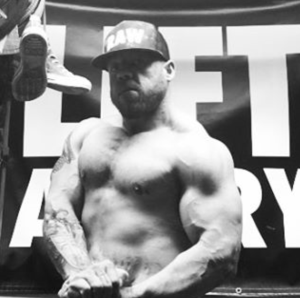 given to flashy training methods, every visit to his IG account yields footage of no frills barbell and dumbbell training in a garage gym decorated only with a Lift Angry poster and one of Arnold Schwarzenegger urging you to conquer. Were he to train in a commercial gym, Wes would be that guy who hardly speaks to anyone; just comes in with headphones on to put in work and leave. Yet he’s generous with his time on Instagram; patiently answering questions about training methods from anyone who asks. That more than anything else is why I decided we needed to have an indepth conversation with this strong but humble garage athlete.
given to flashy training methods, every visit to his IG account yields footage of no frills barbell and dumbbell training in a garage gym decorated only with a Lift Angry poster and one of Arnold Schwarzenegger urging you to conquer. Were he to train in a commercial gym, Wes would be that guy who hardly speaks to anyone; just comes in with headphones on to put in work and leave. Yet he’s generous with his time on Instagram; patiently answering questions about training methods from anyone who asks. That more than anything else is why I decided we needed to have an indepth conversation with this strong but humble garage athlete.
Wes, glad to have a conversation with you about your training. How long have you been exercising?
I’ve been exercising over half my life. I started weight lifting in Junior High School for football, and continued throughout high school, where lifting actually became more of a passion of mine than football.
Have you ever trained in a commercial gym?
Yes, I spent a few years training at a Gold’s Gym. It is a very nice facility, but I have always preferred putting in my headphones and training alone.
What led you to train at home? I started at Gold’s when they first opened in 2003, but by 2006, the membership was so large, that an hour workout would take two hours plus. I have always had equipment at home, but at this point I really started investing in building my own setup.
What was in your first home gym?
The first piece of equipment was a standard 200 lb weight set and bench from Sears, I believe it was a Weider set. At that time, my father was lifting with me, so he went out and bought a 300 lb Olympic set.
What’s the origin of your Instagram handle?
My IG handle is deadliftpro6, the 6 is irrelevant—
I actually thought it was a play on words like, “Deadlift Pro cess?” Since you’re really methodical about your training. Thought you were being clever and now there’s no meaning at all? Thanks a lot Wes!
Ha! Ha! I might have to steal that idea now.
There you go because I’m just telling you flat out, that’s what it is! It’s the deadlift process! You’ve got no choice in the matter ha ha!
Ha ha! Sounds good! But I picked deadliftpro, because if I could pick one lift, that would be it. I’ve come fairly close to mastering my conventional form, and am currently perfecting my sumo form. I’ve helped a lot of people that I’ve trained on their deadlift, and enjoy every second of it. I guess from the years of studying the lift so much, trying to perfect my own form, it has made it easier to spot form or leverage issues when I watch someone else. Although there isn’t much that makes me happier than a new deadlift PR, it makes me equally happy, and honestly a bit proud, when I can help someone else hit a PR, or even something as simple as a small form check to make the lift more comfortable for them.
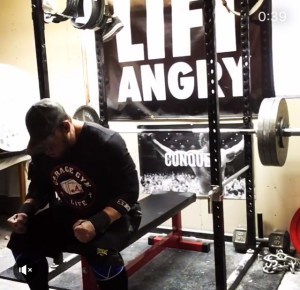 show up dominate leave
show up dominate leaveOk so as far as you started with the basics but you’ve got more than that now. What was the first piece of equipment you bought when you started to expand?
After a few years of just bare bones training in the garage, I invested in a Yukon Fitness Incline/Flat Bench which was quite a bit more heavy duty than what I had used before. I think it was around $400, and at the time, I thought that would be the extent of it, except for maybe some dumbbells.
What’s your favorite piece of equipment now?
That is honestly a toss-up between my Rogue Deadlift Bar, and my Titan Fitness Power Rack. Squatting and deadlifting are my favorite lifts, so I could still enjoy every minute of training, if those were my only two pieces of equipment.
Tell me about something you’ve sold and wished you hadn’t. Mine is a set of 95lb dumbbells that my brother Boo gave me. I got rid of them because I needed to make room on my rack and I’ve been kicking myself ever since. I haven’t bought another set because I’ll have to hear his mouth. But I need them so I’ll probably have to suck it up.
Oh man, I was handed down a Buddy Capps Texas Squat Bar before I got serious about powerlifting, and a friend offered me $300 for it. I jumped on that thinking I could buy a few more pieces of equipment with the money. That was also before I realized how important the right bar is for each lift. Now though, I’m in need of a legit power bar for squatting, and don’t want to spend $500 on another one. Like you said though, I’ll probably have to eventually bite the bullet and do it!
What’s on your wishlist for equipment?
Aside from another Texas Squat Bar, I’d really like to get a Prowler. I remember pushing sleds in football, and how fast our conditioning improved. So that will probably be next.
Training and Nutrition
Back to the deadliftpro6, (ha see what I did there?), describe your training and nutrition philosophy.
My training philosophy is old school. Just shut up and do the work, don’t run from your weaknesses, embrace them, and annihilate them. Too many people just stick to a few lifts that are comfortable, and never see where they could be if the pushed the pain threshold. If squats are your worst lift, my first advice would be to do it twice as often. No one has any amazing stories about the gains they made, or a lifetime PR they hit, by taking it easy, and skipping the stuff that seems more like work than fun. Nutritionally, it’s pretty simple. I aim for 1g of protein per pound of bodyweight, and carb cycle which is dependent on the training day. I’ll shift my protein up to 1.25-1.5g of protein per pound on non-training days, since I try to hold my carbs under 50 those days. On heavy Squat and Deadlift days, I keep the carbs between 4-500g, and will adjust accordingly if I’m trying to cut weight. Bench Days are moderate days -200-250g right now, since for a majority of the workout, your body is stationary, so you don’t need the same fuel that you would on full body days. I believe in long slow cuts, a pound or two a week at most. Keeping the carbs cycling, allows your body enough fuel to recover and continue to get stronger on the heavy days, and the low carb days are when the weight comes off. So right now carb wise a week would go 250/50/500/250/50/500/50.
I love your quote from Hannibal, “We will find a way, or make one,” how does that apply to your life and your approach to things you encounter when training at home alone?
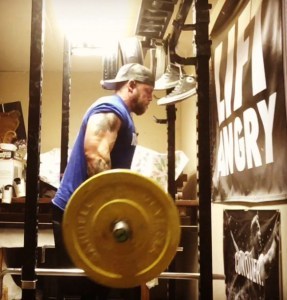 my philosophy is simple just shut up and do the work
my philosophy is simple just shut up and do the workWell to be clear to anyone who isn’t interested in history, I’m not talking about Hannibal Lecter ha ha! Hannibal is known as one of the greatest military commanders in history, as he was a general in the Carthaginian Army. Their military force was massive, and they traveled in the thousands, but they outfitted elephants with armor as part of their force. Other generals and commanders deemed it impossible to cross the Alps with that many men, and all of the elephants in tow. That quote was his response. He was ready to level mountains to achieve his goal. That applies to a lot of things in life. Anything that you are passionate about, or any goal that you have set your heart on, should be undertaken with a similar mentality. I think it applies tremendously to training, in the sense that, especially training alone, you have to set goals, and these goals however lofty they may be, are achievable. There will always be those who tell you no, it’s never going to happen, or you’re too old or too small, and that’s when you have to say to yourself, “This is what I want to achieve, your way may not work for me, Arnold’s way may not work for me, Mark Bell’s way may not work for me, but I will make it happen, my way, no matter what it takes.”
Hannibal ultimately failed in his quest but he’s much more famous that thousands of other generals who succeeded. Would you rather fail gloriously than succeed quietly a la Theodore Roosevelt?
Honestly, yes, I would rather fail, but continue to inspire people to give it their all. Gen. Patton is another one, although he didn’t lose any campaigns, his words and his mentality are what he is most remembered for. Think of King Leonidas as well, he ultimately failed, but in failure, he proved to be one of the toughest men alive. And that inspired his countrymen for generations.
You’ve been leaning out recently, why did you decide to do that around holiday time when most people just go on bulking phases since there’s so much temptation around? Is that another case of finding a way or making one?
Exactly, I am guilty in the past of putting on 5-10 pounds over the holiday season, and once January is here, you have a month of cardio waiting, and I don’t think cakes and pies are worth throwing me that far off course. I love to eat, but I can stay pretty bare bones with it and be content. I also like a challenge, I’m at 216 lbs right now, and would like to be at 212-213 by New Year’s Day.
Do you do mobility work? Yes I do, that has helped my squat depth more than anything. It also has given me more confidence to get back to going 100% after my hamstring tear. Regardless of your program, if you replaced 3 or 4 sets of weight training with 10-15 minutes of mobility work, you would be amazed. You wouldn’t start a cold engine and then floor it, so don’t do the same to your body!
Tell me your overall thoughts about the Bill Starr rehab protocol. It’s a little unusual but it seems to have helped you recover from injuries pretty quickly.
Yes, it does kind of go against the grain of what most therapists/physiologists would recommend. But the amount of athletes that have used it, and swore by it is what got me interested. What it boils down to, is any muscular injury that is in the belly of the muscle, a strain, pull, tear, etc., can be rehabbed by training it directly. This keeps scar tissue from developing around the injury, because you are still doing direct exercises, and in turn the muscle will heal while maintaining the correct neural pattern which keeps the muscle contracting normally. That combined with the influx of blood in the area from the very high rep sets, carries more vitamins and proteins to the area. The more time the area is flushed with blood, the faster the healing process. Again this is for muscle injuries, not injuries that occur at the joint, or connective tissue. Recovery time is quoted at 2 weeks. I felt ready after a week to start going heavier, but stayed the course and PR’d on my first heavy sumo and squat day back.
Training Goals
Let’s talk goals. You train as a powerlifter. Do you compete in powerlifting? No, I don’t currently. I am a member of the USPA, and am hoping to do a meet in the late winter, early spring. Hopefully I’ll have my numbers around 520/365/600 by then.
What are your best numbers so far? You recently hit a 600lb sumo deadlift which was a goal when we first spoke. So that was huge!
Well, since I have yet to compete, my best gym numbers are:
345 paused bench press, 355 touch and go bench press.
560 Conventional Deadlift, and 600 Sumo.
Highest squat was 485 in sleeves, and 530 in wraps. Not a fan of wraps though. Rep PR’s on deadlift are 365×20 sumo and 315×26 Conventional
What’s your ideal weight; where do you plan to compete?
My ideal weight for the longest time was right around 200 pounds, which would keep me within a week or two cut of the 198 class. Right now though, I’m leaner than I have been in a long time at 215-220, depending on water intake. So 220 at my current bodyfat or lower would be ideal to hit over the next year.
You want to compete in 2017 in late winter, early spring, hopefully going over 500 in squat and at least 600 in deadlift. What are your strength goals over the next five years?
In 2017, I want to pull 650, squat 550, and bench 400. A 1,600 total.
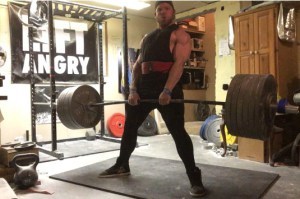 Deadlifts – 600×1. I repeat, 600×1!!! Lifetime PR. This completes my year! December has been the best month I’ve had in a long time in a lot of aspects! Thank you God
Deadlifts – 600×1. I repeat, 600×1!!! Lifetime PR. This completes my year! December has been the best month I’ve had in a long time in a lot of aspects! Thank you God
Not looking any further than that? Okay, eyes on the prey, not the horizon. I get that. So how are you balancing out your desire to look good and to put up bigger numbers?
It comes mostly down to diet. With my job, I get a lunch break at 10am, and usually have greek yogurt, tuna, and two peanut butter sandwiches on Ezekiel bread, but other than that I drink 2 protein shakes at work. I get up at 3 am, and don’t get my first legitimate sit down meal at home until about 3:30 or 4. By that time though, I’ve hit my protein requirement except for post workout, and that makes it easier to monitor my carbs throughout the evening to control my weight. I don’t want to just be a big strong ox, there is nothing wrong with that, but I want to be athletic, be able to run, get rim on a regulation BB hoop, and still pull 600+.
Work/Life Balance
Being a mechanic can be exhausting. How do you make sure you’ve got the energy to train after playing around under a hood all day? Actually that title throws a lot of people off. I’m actually a sheet metal fabricator, and installation mechanic for Kogok Corp., which is the biggest company of its type on the East Coast. It is a very demanding job physically. Since we start high rise buildings from the ground up, there are a lot of stairs to be tackled until a midpoint of the job when they have a service elevator. If we get a 20,000 pound truck full of metal for the fifth floor, it’s going up the stairs.
Do you train before work or after? Although I’m dead somedays when I get home, especially waking up at 3am, it has never affected my training. No matter how hard the work day may be, training is my release, my therapy if you will.
You have Apeman Strong’s Lift Angry poster in your power rack and you wear a number of their products when you train. Is putting that poster up and wearing the shirts a way for you to get psyched up to train?
Yes, I remember before the brand got as big as it is now, I saw George Leeman wearing a Lift Angry shirt. I have always followed his training and being the former American deadlift record holder, I was obviously a fan of his training style. You can be as calm as a kitten any other part of the day, but when it comes time to train, aggression and intensity are key if you want big numbers. Be easy, but lift angry!
So is there a Mrs. deadliftpro6? Some little pro6’es running around?
No I’m not married, I recently started dating an amazing girl though. Currently she doesn’t train, but she does coach volleyball. If she were to decide to train, I’d love it. She realizes how important powerlifting is to me though, and is fully supportive of it, which I’m very thankful for.
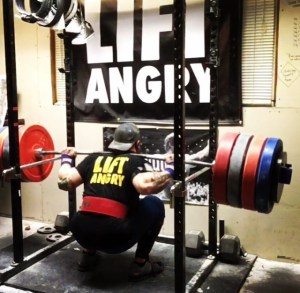 You can be as calm as a kitten any other part of the day, but when it comes time to train, aggression and intensity are key if you want big numbers.
You can be as calm as a kitten any other part of the day, but when it comes time to train, aggression and intensity are key if you want big numbers.I asked that because even when training at home, we all have to balance our goals and our relationships. How do you maintain that balance? Especially since you’re in a new relationship where you’re trying to get to know each other and you both work such long days? And then on top of that, you’re pursuing a sport that doesn’t really have an off season?
I mean, it definitely is a work in balancing. Because she and I actually had a talk not too long ago and when she was first finding out how important is to me, she was like. Well, I know you lift five or six days a week but if something comes up or somebody needs your help or wants to make plans are you like, “No. I have to lift first?” or are you willing to miss a day. And I was like, “Well, of course I like to get my lifts in but that’s a very important thing to me next to some other important things like our relationship and my religion and stuff like that. I can put it on the backburner for things and I think that’s necessary to keep a good balance and not overdo it and make the other things kind of be left out or replaced by lifting per se.
What advice do you have for someone just starting out in either exercise or who’s thinking about working out at home?
Find a buddy, be it a friend who trains, someone online, or even someone else who is just starting. Study and share knowledge, don’t be afraid to ask questions, or to fail. If you are serious about your health and well-being, you want to make it a lifelong venture. You don’t need to compete, or have the top of the line equipment. A pair of bands and some dumbbells is sufficient to make yourself better. The most important thing is do it for you. Train in the way that makes it enjoyable, it will go a long way in helping you stick with it!
Do you train people? I know you answer a ton of questions from people who follow you but do you do it professionally?
I am currently training two people. One of them will compete with me in the same weight class. I completed an ACE certification, but with that not being my profession, I don’t charge anyone. Ideally though, being a strength and powerlifting coach would be the job that I would enjoy waking up to everyday.
How can people contact you if they want to ask you questions about training or nutrition?
Feel free to shoot me a DM @deadliftpro6, or email me at wjenkins022@gmail.com, I would be glad to be of any assistance to anyone
Last question. Here’s your chance to be heard! What one thing do you wish we carried in the Garage Gym Life store?
I can’t really ask for more clothing wise, because you have a great selection of quality stuff. One thing I would buy in a heartbeat though, and display it proudly beside my Lift Angry banner, is a Garage Gym Life banner. If you forayed into wrist wraps and lifting straps, some of the smaller accessories like that, I’m sure they would do very well. I haven’t seen anything that you’ve made yet that is less than stellar quality.
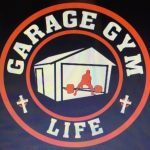 Wes knows how to get results! A few other people had asked me about banners but it wasn’t until Wes brought it up that I got to work. You can order a Garage Gym Life 3×3 banner by sending $30 to john@garagegymlife.net via PayPal. Residents of the continental United States add $10 shipping and handling and international customers will pay $25 for shipping. Please include address information with your order and allow 2-3 weeks processing time once your order is received.
Wes knows how to get results! A few other people had asked me about banners but it wasn’t until Wes brought it up that I got to work. You can order a Garage Gym Life 3×3 banner by sending $30 to john@garagegymlife.net via PayPal. Residents of the continental United States add $10 shipping and handling and international customers will pay $25 for shipping. Please include address information with your order and allow 2-3 weeks processing time once your order is received.
Related articles
 The basic tenets of lifting weights and building muscle
The basic tenets of lifting weights and building muscle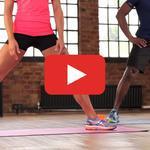 The 7-Minute High-Intensity Workout for Stronger Legs
The 7-Minute High-Intensity Workout for Stronger Legs Britain’s strongest man bench presses four women
Britain’s strongest man bench presses four women Florida veteran sets weightlifting records
Florida veteran sets weightlifting records 22 Minutes. 11 High-Intensity Moves. One Kick-Ass Total-Body Workout.
22 Minutes. 11 High-Intensity Moves. One Kick-Ass Total-Body Workout.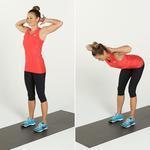 5 of the Best Exercises for Overall Fitness
5 of the Best Exercises for Overall FitnessThe post The DeadliftPro6 with Wes Jenkins appeared first on Garage Gym Life.
John Greaves III's Blog
- John Greaves III's profile
- 1 follower






